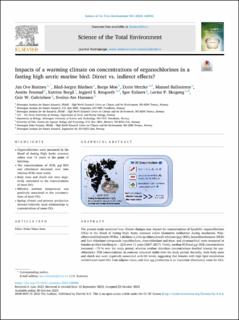Impacts of a warming climate on concentrations of organochlorines in a fasting high arctic marine bird: Direct vs. indirect effects?
| dc.contributor.author | Bustnes, Jan Ove | |
| dc.contributor.author | Bårdsen, Bård-Jørgen | |
| dc.contributor.author | Moe, Børge | |
| dc.contributor.author | Herzke, Dorte | |
| dc.contributor.author | Ballesteros, Manuel | |
| dc.contributor.author | Fenstad, Anette | |
| dc.contributor.author | Borgå, Katrine | |
| dc.contributor.author | Krogseth, Ingjerd Sunde | |
| dc.contributor.author | Eulaers, Igor | |
| dc.contributor.author | Skogeng, Lovise Pedersen | |
| dc.contributor.author | Gabrielsen, Geir Wing | |
| dc.contributor.author | Hanssen, Sveinn Are | |
| dc.date.accessioned | 2023-12-04T08:04:11Z | |
| dc.date.available | 2023-12-04T08:04:11Z | |
| dc.date.created | 2023-11-28T14:50:58Z | |
| dc.date.issued | 2023 | |
| dc.identifier.citation | Science of the Total Environment. 2023, 908, 168096. | en_US |
| dc.identifier.issn | 0048-9697 | |
| dc.identifier.uri | https://hdl.handle.net/11250/3105702 | |
| dc.description.abstract | The present study examined how climate changes may impact the concentrations of lipophilic organochlorines (OCs) in the blood of fasting High Arctic common eiders (Somateria mollissima) during incubation. Polychlorinated biphenyls (PCBs), 1-dichloro-2,2-bis (p-chlorophenyl) ethylene (p,p′-DDE), hexachlorobenzene (HCB) and four chlordane compounds (oxychlordane, trans-chlordane and trans- and cis-nonachlor) were measured in females at chick hatching (n = 223) over 11 years (2007–2017). Firstly, median HCB and p,p′-DDE concentrations increased ~75 % over the study period, whereas median chlordane concentrations doubled (except for oxychlordane). PCB concentrations, in contrast, remained stable over the study period. Secondly, both body mass and clutch size were negatively associated with OC levels, suggesting that females with high lipid metabolism redistributed more OCs from adipose tissue, and that egg production is an important elimination route for OCs. Thirdly, the direct climate effects were assessed using the mean effective temperature (ET: air temperature and wind speed) during incubation, and we hypothesized that a low ET would increase redistribution of OCs. Contrary to expectation, the ET was positively correlated to most OCs, suggesting that a warmer climate may lead to higher OCs levels, and that the impact of ET may not be direct. Finally, potential indirect impacts were examined using the Arctic Oscillation (AO) in the three preceding winters (AOwinter 1–3) as a proxy for potential long-range transport of OCs, and for local spring climate conditions. In addition, we used chlorophyll a (Chla) as a measure of spring primary production. There were negative associations between AOwinter 1 and HCB, trans-chlordane and trans-nonachlor, whereas oxychlordane and cis-chlordane were negatively associated with Chla. This suggests that potential indirect climate effects on eiders were manifested through the food chain and not through increased long-range transport, although these relationships were relatively weak. | en_US |
| dc.language.iso | eng | en_US |
| dc.rights | Navngivelse 4.0 Internasjonal | * |
| dc.rights.uri | http://creativecommons.org/licenses/by/4.0/deed.no | * |
| dc.title | Impacts of a warming climate on concentrations of organochlorines in a fasting high arctic marine bird: Direct vs. indirect effects? | en_US |
| dc.title.alternative | Impacts of a warming climate on concentrations of organochlorines in a fasting high arctic marine bird: Direct vs. indirect effects? | en_US |
| dc.type | Peer reviewed | en_US |
| dc.type | Journal article | en_US |
| dc.description.version | publishedVersion | en_US |
| dc.rights.holder | © 2023 The Authors. Published by Elsevier B.V. | en_US |
| dc.source.pagenumber | 11 | en_US |
| dc.source.volume | 908 | en_US |
| dc.source.journal | Science of the Total Environment | en_US |
| dc.identifier.doi | 10.1016/j.scitotenv.2023.168096 | |
| dc.identifier.cristin | 2204128 | |
| dc.relation.project | Norges forskningsråd: 287114 | en_US |
| dc.relation.project | NILU: 119008 | en_US |
| dc.relation.project | NILU: 122058 | en_US |
| dc.source.articlenumber | 168096 | en_US |
| cristin.ispublished | true | |
| cristin.fulltext | original | |
| cristin.qualitycode | 2 |
Tilhørende fil(er)
Denne innførselen finnes i følgende samling(er)
-
Publikasjoner fra Cristin - NILU [1377]
-
Vitenskapelige publikasjoner [1112]
Vitenskapelige artikler, kapitler og monografier.

